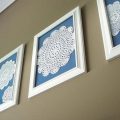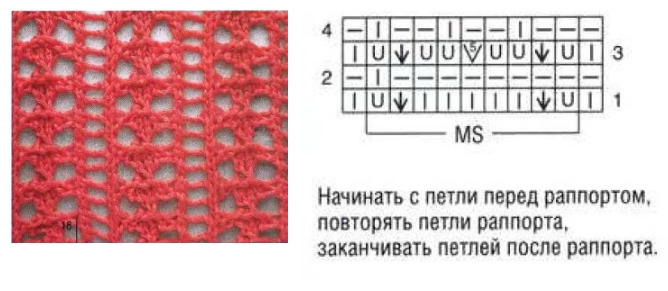Ornament and pattern in the interior. Experiment or tradition? (37 photo)
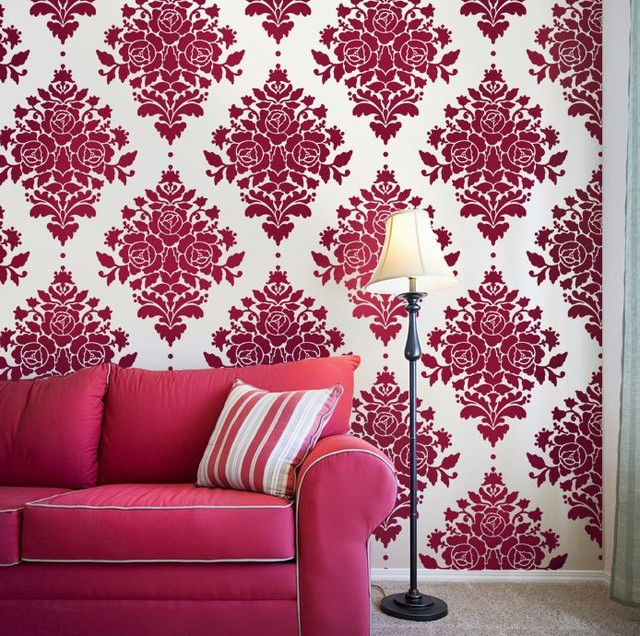 We decorate the interior with wallpaper with a patternMan is distinguished by the desire for beauty and the improvement of the world. This is the foundation, it’s laid down, there is nothing you can’t do and you won’t run anywhere from it. Watching the changes in nature, the natural course of life, he transferred the peeped into the drawing, decorated it with a house, temple, book, sculpture. At first they were simple geometric shapes: circle, oval, spiral. Symbols were endowed with meanings. The circle is the sun, the earth is square, the mountains are triangles. They are still alive, present in sacred everyday culture. Painted Easter eggs are an obvious example.
We decorate the interior with wallpaper with a patternMan is distinguished by the desire for beauty and the improvement of the world. This is the foundation, it’s laid down, there is nothing you can’t do and you won’t run anywhere from it. Watching the changes in nature, the natural course of life, he transferred the peeped into the drawing, decorated it with a house, temple, book, sculpture. At first they were simple geometric shapes: circle, oval, spiral. Symbols were endowed with meanings. The circle is the sun, the earth is square, the mountains are triangles. They are still alive, present in sacred everyday culture. Painted Easter eggs are an obvious example.  Diamonds in the kitchen in neutral colors Read moremore. The human artist did not cease to observe and draw. So arabesques appeared - an Arabian floral ornament that struck the world. Drawings using countless repetitions of plant design elements. One fragment flows from another, intertwined, repeated. The arabesques are so dense that the background, as a separate highlighted color, is practically absent in them. They have a rhythm, their own language, their own music and philosophy. So what is interesting to us ornament and pattern?
Diamonds in the kitchen in neutral colors Read moremore. The human artist did not cease to observe and draw. So arabesques appeared - an Arabian floral ornament that struck the world. Drawings using countless repetitions of plant design elements. One fragment flows from another, intertwined, repeated. The arabesques are so dense that the background, as a separate highlighted color, is practically absent in them. They have a rhythm, their own language, their own music and philosophy. So what is interesting to us ornament and pattern? 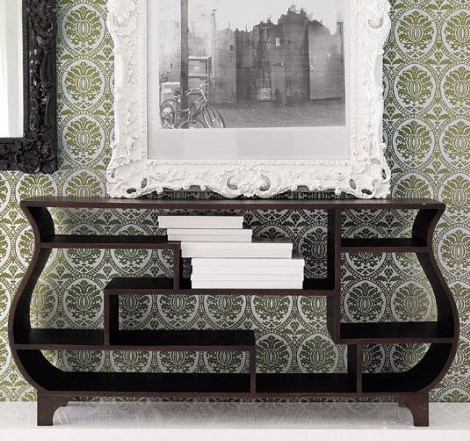 Ornament in the interior Contents
Ornament in the interior Contents
We decorate the walls. Ornaments in the interior
Designers are practical people. They invent a new one on the basis of the already known, modernize, improve and successfully apply. Ornaments are:
- geometric;
- vegetable;
- meander, in the form of corners, rhombuses, triangles accompanying an incessant, leaving line.
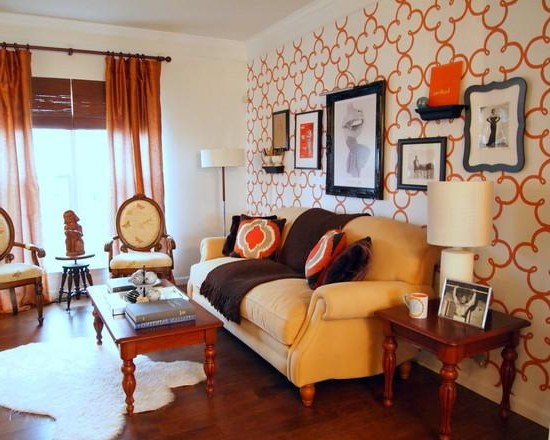 Do not be afraid to experiment with patterns on the wall
Do not be afraid to experiment with patterns on the wall
Damask pattern
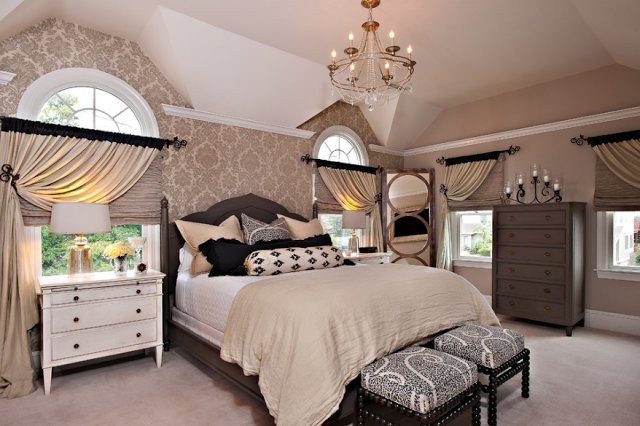


 One of the most popular ornaments of our time. Repeats a floral pattern, framed in ornate, complex frames, countless times. Its lines are directed vertically downward, as if falling, flowing down, moving. Damascus is never flashy, it is elegantly restrained, unobtrusive, but, nevertheless, certainly rich, attracts attention. Damask wallpaper. Typically used in classic interiors. They paste over all the walls or just one to create an accent, to give the room the opportunity to express itself, to get rid of the coldness of minimalism and depressing simplicity. A little refinement, pretentiousness does not hurt when additions are made in moderation. If you do not mind taking a chance, then pay attention to the black and white palette of wallpapers on sale. At first glance, unexpectedly, in fact - spectacularly. Such wallpapers have become fashionable and have not scared anyone for a long time. You should not glue them on all walls, only one is enough, for example, in the bedroom, at the head of the bed. This way you create an accent wall. Damask fabrics are successfully present in other elements of the decor. They are surrounded by sofas, chairs, armchairs, decorated with pillows and poufs.
One of the most popular ornaments of our time. Repeats a floral pattern, framed in ornate, complex frames, countless times. Its lines are directed vertically downward, as if falling, flowing down, moving. Damascus is never flashy, it is elegantly restrained, unobtrusive, but, nevertheless, certainly rich, attracts attention. Damask wallpaper. Typically used in classic interiors. They paste over all the walls or just one to create an accent, to give the room the opportunity to express itself, to get rid of the coldness of minimalism and depressing simplicity. A little refinement, pretentiousness does not hurt when additions are made in moderation. If you do not mind taking a chance, then pay attention to the black and white palette of wallpapers on sale. At first glance, unexpectedly, in fact - spectacularly. Such wallpapers have become fashionable and have not scared anyone for a long time. You should not glue them on all walls, only one is enough, for example, in the bedroom, at the head of the bed. This way you create an accent wall. Damask fabrics are successfully present in other elements of the decor. They are surrounded by sofas, chairs, armchairs, decorated with pillows and poufs.
Paisley ornament in the interior



 The pattern is also called Turkish or Indian cucumber,which directly indicates its eastern origin. Colors (that is, their images) are not here, apparently the designers are fed up with the topic. But there are big, heavy, imposing drops that are tiredly spread out according to the wallpaper pattern. They are placed in different poses (as if they relaxed and relax), go in different directions. Delicate paisley from thin, smoothly drawn lines in warm colors look cute. They are somewhat reminiscent of a grandmother's chintz dressing gown “in cucumbers,” which directly hints at mundane, sweet, prose of life. Such wallpapers can be safely glued in the nursery, where babies grow safely, gain strength.
The pattern is also called Turkish or Indian cucumber,which directly indicates its eastern origin. Colors (that is, their images) are not here, apparently the designers are fed up with the topic. But there are big, heavy, imposing drops that are tiredly spread out according to the wallpaper pattern. They are placed in different poses (as if they relaxed and relax), go in different directions. Delicate paisley from thin, smoothly drawn lines in warm colors look cute. They are somewhat reminiscent of a grandmother's chintz dressing gown “in cucumbers,” which directly hints at mundane, sweet, prose of life. Such wallpapers can be safely glued in the nursery, where babies grow safely, gain strength.
Grill pattern



 Dynamic, active, pulsating, monochrome,that is, monochrome. Its complex interweaving can be found everywhere: whether it is the binding of a wooden arbor or the metal gate. Lattice - a successful find in the interior of an apartment or house, avoids the uniformity of housing, creates the illusion of volume, expanding the space. The pattern combines Greek elements of vase painting, Moroccan decorativeness, pastoral sincerity and purity of forms, classical straightforwardness of lines.
Dynamic, active, pulsating, monochrome,that is, monochrome. Its complex interweaving can be found everywhere: whether it is the binding of a wooden arbor or the metal gate. Lattice - a successful find in the interior of an apartment or house, avoids the uniformity of housing, creates the illusion of volume, expanding the space. The pattern combines Greek elements of vase painting, Moroccan decorativeness, pastoral sincerity and purity of forms, classical straightforwardness of lines.
Goose foot ornament



 It is also called a broken cell. I found a foot, fell in love and made incredibly fashionable Coco Chanel, who used the ornament in her collections, creating ladies' clothing from the claw cloth. The drawing is more abstract, dynamic, running, better - running away. With a light hand, Coco ornament received the status of one of the most elegant. It organically fits into strict classics, is used in the design of cabinets with heavy furniture. Invaluable in black and white interiors. We are talking about upholstery and textiles. Here, as indeed everywhere, a measure is needed. With an abundance of goose paws just flashes in the eyes. Such an interior is clearly oversaturated, unsuccessful, crushing and depressing. Wallpaper goose foot is quite rare, but if you really like it and really want it, then the foot can be applied to painted walls using the stencil method. Only one wall is pasted over with such wallpaper. Harmoniously combined, applicable in the same room, a similar armchair in the "grouse", or a carpet or curtain. In modern interiors, combinations of stripes and different geometric shapes are widely used. And here one can not help but mention the famous Scottish cage.
It is also called a broken cell. I found a foot, fell in love and made incredibly fashionable Coco Chanel, who used the ornament in her collections, creating ladies' clothing from the claw cloth. The drawing is more abstract, dynamic, running, better - running away. With a light hand, Coco ornament received the status of one of the most elegant. It organically fits into strict classics, is used in the design of cabinets with heavy furniture. Invaluable in black and white interiors. We are talking about upholstery and textiles. Here, as indeed everywhere, a measure is needed. With an abundance of goose paws just flashes in the eyes. Such an interior is clearly oversaturated, unsuccessful, crushing and depressing. Wallpaper goose foot is quite rare, but if you really like it and really want it, then the foot can be applied to painted walls using the stencil method. Only one wall is pasted over with such wallpaper. Harmoniously combined, applicable in the same room, a similar armchair in the "grouse", or a carpet or curtain. In modern interiors, combinations of stripes and different geometric shapes are widely used. And here one can not help but mention the famous Scottish cage.
Scotch (tartan)
Formally, you can call Scotch anycheckered fabric. The Scots used to designate their clan purely one color, which carried a semantic load. Blue with red is one community, green and yellow are completely different, so keep your distance and respect the coalition. English Queen Victoria, whose name is called an entire era, was a passionate admirer of this harsh country. Thanks to her, the Scottish (or tartan) confidently became fashionable. 


 A cell is traditionally considered a masculine ornament,for Scotland is the land of restrained emotions and harsh landscapes. Therefore, it is a priority in classrooms and children's rooms for teenage boys. This is the British spirit and country style. Of course, decorate the village house. Checkered tablecloth on the table in the kitchen, the same curtains - the absolute atmosphere of comfort, harmony and a hint of continuity of generations. Wallpaper and interior fabrics of tartan Leading modern designers, trendsetters, boldly play with the scale. Tartan, like a giant cage on the walls, looks exciting and ultramodern, but loves high ceilings and long wide walls. In an apartment measuring 50 meters, you can stick wallpaper giants. The only question is how it will look.
A cell is traditionally considered a masculine ornament,for Scotland is the land of restrained emotions and harsh landscapes. Therefore, it is a priority in classrooms and children's rooms for teenage boys. This is the British spirit and country style. Of course, decorate the village house. Checkered tablecloth on the table in the kitchen, the same curtains - the absolute atmosphere of comfort, harmony and a hint of continuity of generations. Wallpaper and interior fabrics of tartan Leading modern designers, trendsetters, boldly play with the scale. Tartan, like a giant cage on the walls, looks exciting and ultramodern, but loves high ceilings and long wide walls. In an apartment measuring 50 meters, you can stick wallpaper giants. The only question is how it will look.
Quatrefoil pattern
Four leaf or trefoil (quadrofolium andtrifolium) - a geometric ornament with intersecting circles. The pattern is complemented by the corners at the joints. The history of motives also goes back centuries. The Renaissance adopted these figures, decorating them with furniture, windows, mosaics and stained-glass windows. It is found in interiors stylized as Gothic, Baroque. Organic, soft, a little bizarre. Four-leaf patterns are found on ceramic floor tiles and on the most unexpected objects. For example, a mirror of this shape, with emphasized sharp corners, will look rich and impressive in your bathroom. 



Meander pattern
The word is Greek, the ornament is also Greek. It was once called the river flowing in Asia Minor. Now the name is changed. Seneca believed that watching her twisty channel inspire philosophers and poets to reflect on the nature of the Main. A meander can only consist of straight lines, lines going to infinity, and right angles. 


 In fact, the meander is a border inthe form of a bizarre, different geometric shapes, border. The meander is decorated with walls, curtains, carpet products. Often use combinations of ornaments of plant motifs and meanders.
In fact, the meander is a border inthe form of a bizarre, different geometric shapes, border. The meander is decorated with walls, curtains, carpet products. Often use combinations of ornaments of plant motifs and meanders.
Scale Pattern
The name of the pattern “scales” already speaks for itself. The peak of popularity came in the fifties of the last century. Ideal for recreating a retro style. Tile-scales on the walls in the kitchen is a classic example of such an ornament. We can not ignore ethnic patterns. The room will literally “sparkle” if it is not a classic carpet bought in a store that is laid on the floor, but home-woven rugs and stripes. Embroidered pillows, handmade drapes, crocheted tablecloths - everything has returned, the tradition of the Russian house is relevant and in demand.  Scales in the interior. Do not disdain eclecticism. By and large - it is also the style and variety of patterns that successfully saturate the interior. Do not be afraid to experiment. Let the stripes, lines and figures slide from the walls to the bed, conveniently fold on the sofas. Group several decor items with colorful ornaments at once. Variegated pillows look great against a neutral background of walls. Hang decorative plates: wooden, ceramic, painted. Use ornaments and patterns on all kinds of surfaces. It refreshes the space, breathes life into your home.
Scales in the interior. Do not disdain eclecticism. By and large - it is also the style and variety of patterns that successfully saturate the interior. Do not be afraid to experiment. Let the stripes, lines and figures slide from the walls to the bed, conveniently fold on the sofas. Group several decor items with colorful ornaments at once. Variegated pillows look great against a neutral background of walls. Hang decorative plates: wooden, ceramic, painted. Use ornaments and patterns on all kinds of surfaces. It refreshes the space, breathes life into your home. 


 There are many kinds of ornaments and patterns. There is no need to list them. Key examples are compiled and presented in this article. Let us dwell on a few rules that experienced designers recommend following. They need to be mistaken for axioms.
There are many kinds of ornaments and patterns. There is no need to list them. Key examples are compiled and presented in this article. Let us dwell on a few rules that experienced designers recommend following. They need to be mistaken for axioms.
The right combination of ornaments and patterns in the interior
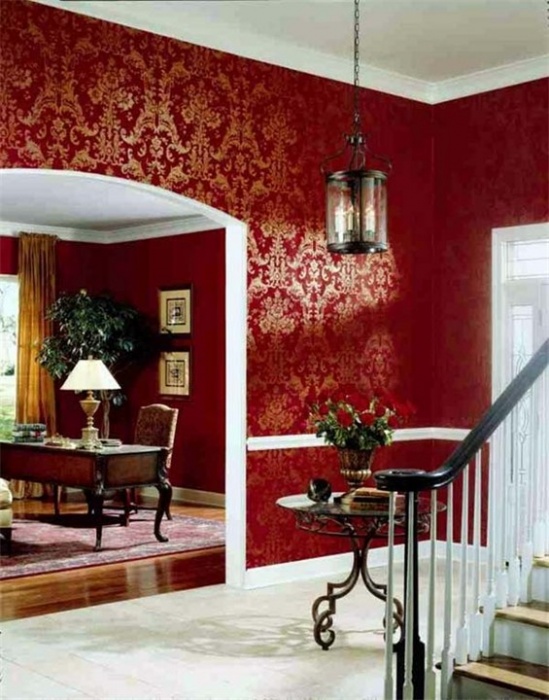 Wallpaper ornament
Wallpaper ornament
- Combine prints. You need to start with three different-sized species. Remember the "rule of three." This is the beginning, the starting point. Then you can experiment with a lot.
- Combine small and large patterns and ornaments. We recall the rule of the first paragraph. The pattern is large, medium and smallest.
- Large patterns “love” volumes. Suitable for large rooms, rooms, studios. There is where to turn around and prove yourself at full power.
- The main pattern is always large and includes interior colors.
- In a restrained monochrome interior they play with shades of a pattern. Balance the patterns in space. They must successfully "sit down", otherwise it will simply charge in the eyes.
- The ornament is chosen with sequential shades. Pile of ornaments of different colors and shades leads to chaos.
- Do not be afraid to break the rules. Risk is a noble cause.
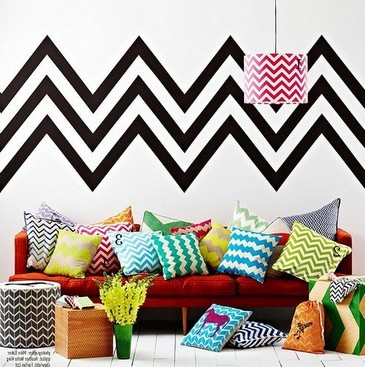 These zigzags make the room ultra-modern Do you like this article? Share on social networks!
These zigzags make the room ultra-modern Do you like this article? Share on social networks!
